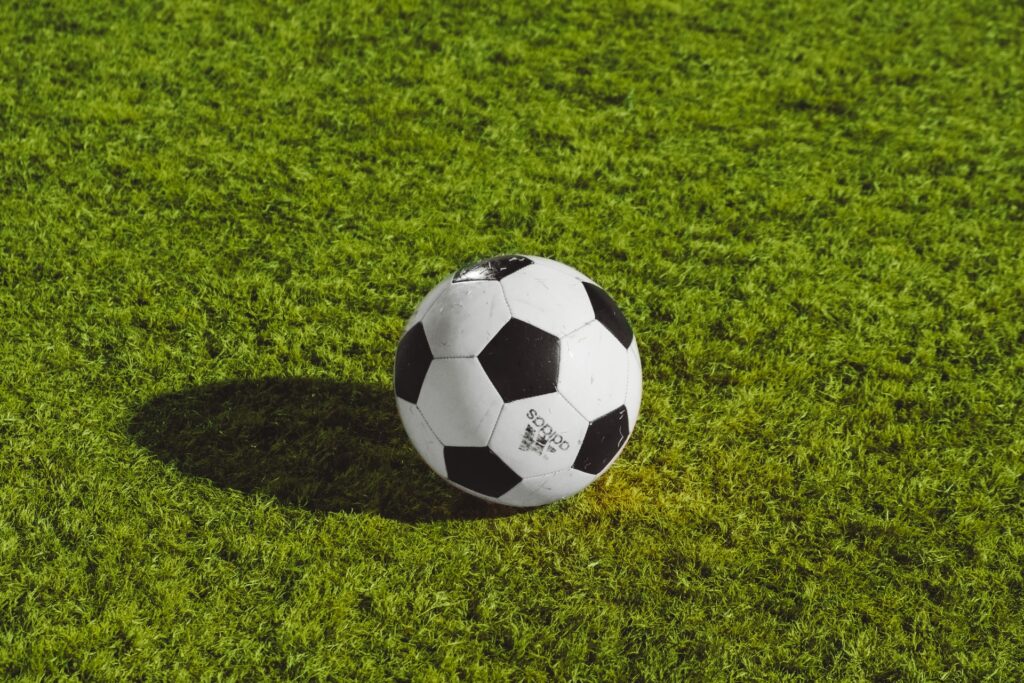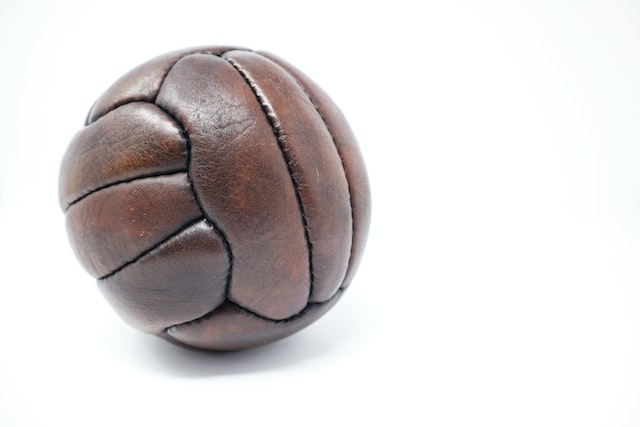*Our published content contains affiliate links that may lead to a small commission. Full disclosure here.
Soccer balls have come a long way since players kicked animal bladders around a field in the middle of the nineteenth century!
Even the classic, old leather balls of the early-mid twentieth century seem alien to us in the present day.
So, with that in mind, we introduce you to the interesting evolution of old leather soccer balls and explain where you can still buy one to add to your soccer ball collection if you wish.
What is an old leather soccer ball?
Before synthetic materials were widely available, soccer balls were made out of leather. They were extremely heavy and not well suited to the game, but it was the best material available at the time. Synthetic materials replaced leather by the 1970s, and soccer balls became lighter, more durable, and more affordable.
In spite of this, there’s something magical about the appearance of an old leather soccer ball. The intricate detail and stitching on the leather cover make them a great statement piece to add to your soccer collection.
In the sections that follow, we introduce you to a brief history of the leather soccer ball and show you our top pick if you want to buy an old leather soccer ball this season.
The history of the leather soccer ball
The first official soccer ball can be traced back to 1863 when the original “association football” was created. In the years prior to 1863, soccer was played with an inflated animal bladder.
While ingenious in many respects, animal bladders were prone to punctures, particularly because soccer was played on rough surfaces.
As well as animal bladders, some people created soccer balls from cork and leather, but these were less frequent as leather was more expensive.
Just under a decade later, in 1972, the recently established Football Association created specifications regarding the production of soccer balls, ensuring that minimum standards were met.
These standards were made possible by the work of Charles Goodyear, who introduced vulcanized rubber in the nineteenth century. Vulcanisation enabled soccer ball producers to create balls that were strong, elastic, and puncture-resistant.
Following Goodyear’s innovations, most soccer balls were made with tanned leather, incorporating stitches into the fabric to secure it in place.
The birth of the leather ball
By the early 1900s, leather balls were widely used throughout Europe, from England to Spain. Players found the early leather balls to be extremely strong and ideal for kicking.
However, when it came to heading, leather balls proved to be more of a problem, particularly when matches were taking place in the rain.
Leather absorbs water when it’s wet, and the additional weight of the soccer ball resulted in multiple head and neck injuries among the players of the time.
Another issue that became quickly apparent with leather soccer balls was that they wore out pretty quickly. While leather is extremely durable, soccer balls were typically made with inferior quality leather.
By the 1930s, the original leather ball developed for soccer was put under the microscope, and some significant changes were made.
In 1931, an Argentinian by the name of Romano Polo changed the style of soccer balls for good. The key innovation saw Polo and his colleagues remove the stitches from the outside of the ball.
This made the soccer ball a complete sphere, and the problematic laces no longer caused players issues out on the field. Polo was so pleased with his design that he named it “The Superball,” and its concept has been used in soccer ever since.
Leather to synthetic balls

By the 1960s, soccer associations around the world realized that the time of the leather ball had come to an end. Synthetic soccer balls were cheaper to produce, easier and lighter to play with, and less likely to cause injury.
Most of the soccer balls from the 1960s onwards consist of a design that was pioneered by American Richard Buckminster Fuller, which comprises of a series of pentagons or hexagons fitted together to make a sphere.
You’ve almost certainly seen images of the original Buckminster ball, which has black and white pentagons. The black pentagons were added to help players judge the movement of the soccer ball in the air.
The first Buckminster soccer ball to be used at a World Cup was the Adidas Telstar that debuted in 1970. The Mexico World Cup was Pele’s tournament, and the Brazilian legend excelled with the new soccer ball.
Today, soccer balls consist of multiple layers and typically comprise latex and synthetic leather. It’s very rare to come across a soccer ball that is made exclusively of leather in the present day.
Can you still buy old leather soccer balls?
Although leather soccer balls are no longer used in competitive soccer, you can still buy old leather soccer balls if you know where to look!
We absolutely love this vintage old leather soccer ball, from FNine Sports. It’s ideal as a statement piece in your home, or you can use it for novelty games of soccer with your friends.

However, we wouldn’t recommend using it if you play soccer in the rain. As mentioned already, leather soccer balls get super heavy in the rain and can lead to head, neck, or back injuries.
But if you want to treat yourself to a unique item that will look great at home, this old leather soccer ball is the perfect choice for you.
Why are leather soccer balls no longer used?
The main reason that old leather soccer balls have been shelved is that they’ve been replaced by synthetic balls. These are much easier to produce and are much better for the game.
Soccer used to be played at a much slower pace than it is today, and it would be nigh on impossible for modern-day soccer players to play the fast-paced game that we all love with a heavy leather soccer ball.
So, while they look great, old leather soccer balls are essentially just collector’s items today and aren’t suitable for use in a competitive soccer match.
Recap: Old leather soccer balls
There’s a lot to love about the appearance of old leather soccer balls. Made from vintage leather, they can be a great addition to your soccer collection.
However, thanks to the availability of lightweight synthetic materials, leather soccer balls are no longer played with at any level of the game.
Still, if you think they look great, there’s no reason not to invest in an old leather soccer ball to add to your home-office shelves.

